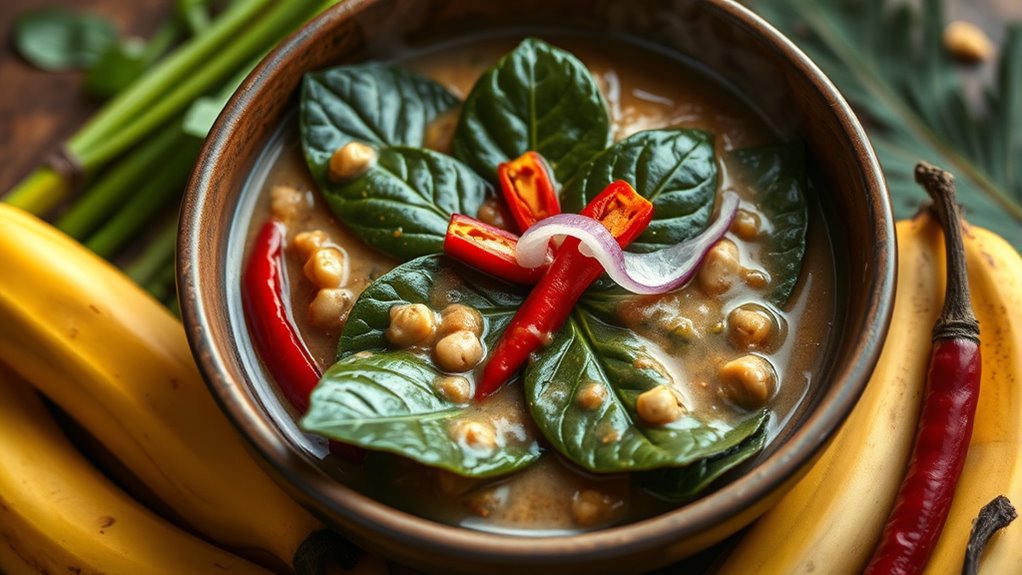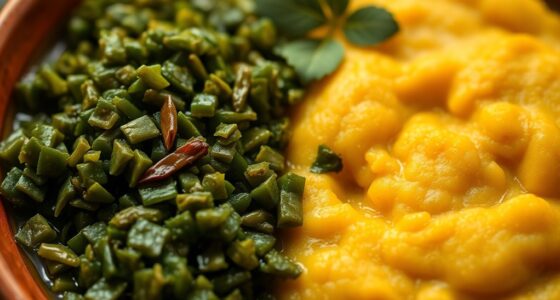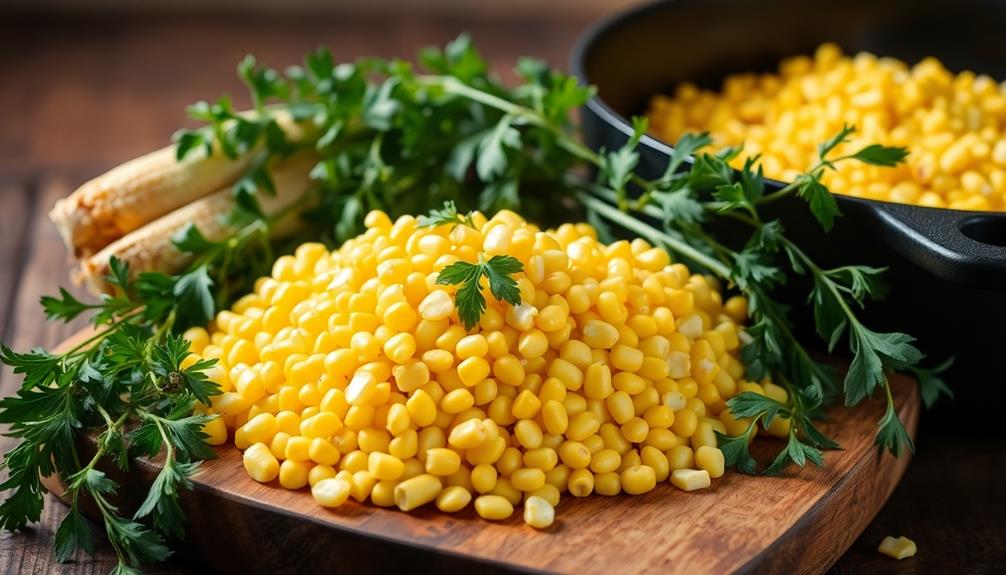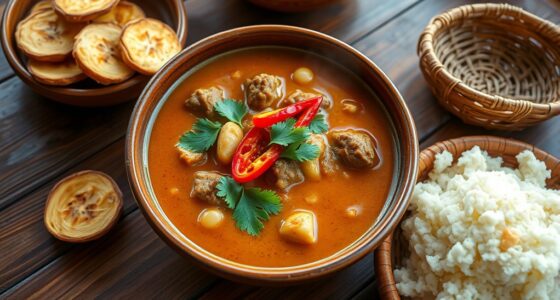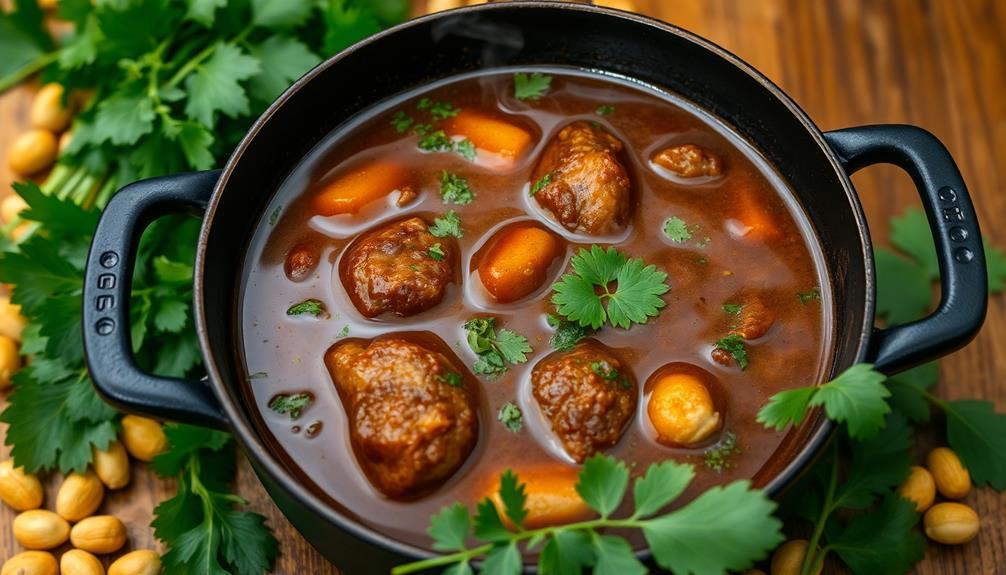To balance the bitterness of bitterleaf Ndolé, start by combining herbs like spinach or water leaves to soften the flavor, adding depth without overpowering. Incorporate garlic, onions, and local spices like Cameroon pepper to boost warmth and complexity. Use acidity, such as a splash of lemon or palm oil, to brighten the dish, and add herbs early enough to soften but avoid overcooking. Mastering these techniques helps create a harmonious, flavorful Ndolé—you’ll discover how each element works together for perfect balance.
Key Takeaways
- Incorporate greens like spinach or water leaves early to soften bitterness without overpowering the dish.
- Balance herbs and spices by adding garlic, ginger, and local seasonings gradually for harmonious flavor layering.
- Use acidity such as lemon juice or palm oil to brighten flavors and reduce the perception of bitterness.
- Avoid overcooking greens to preserve vibrant color and prevent bitterness from intensifying.
- Adjust seasoning carefully, tasting progressively to achieve a well-rounded flavor profile without harsh bitterness.
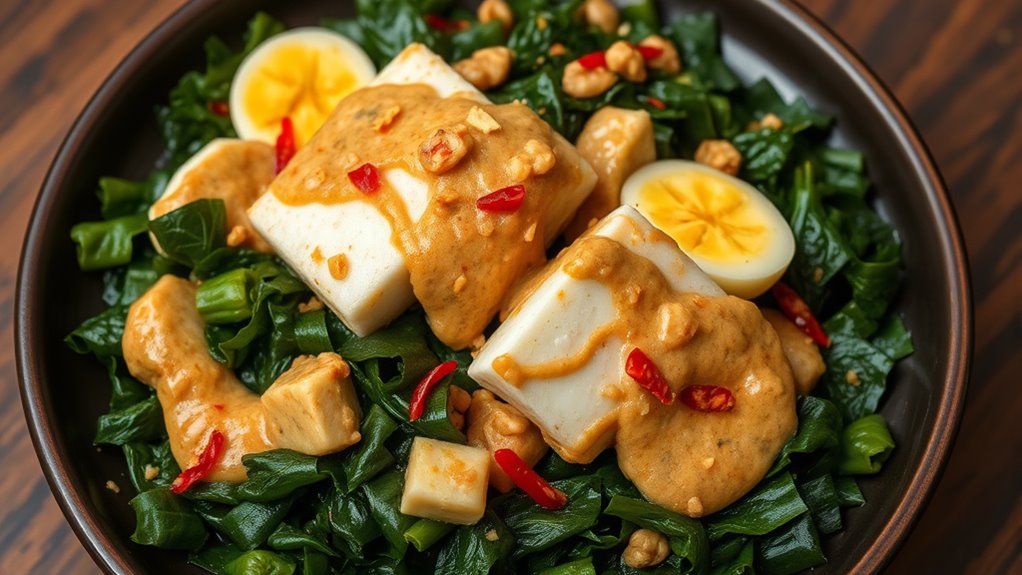
Ndolé, a beloved Cameroonian dish, is renowned for its rich combination of flavors that can easily overwhelm or underwhelm if not balanced properly. When preparing this traditional stew, you become the master of harmony, carefully blending ingredients to achieve that perfect taste. One of the key elements in balancing the flavors is understanding the herb combinations that bring complexity without overpowering the dish. You’ll want to incorporate herbs like bitterleaf, which provides the distinctive bitterness, along with other greens such as spinach or water leaves to soften and complement its sharpness. These herb combinations create a layered flavor profile that keeps each bite interesting, without letting the bitterness dominate.
Using a savory seasoning is equally important in maintaining the right balance. You might start with ingredients like garlic, onions, and ginger—staples that add depth and warmth—then layer in local spices like Cameroon pepper or cayenne for a gentle heat. The goal is to enhance the natural flavors, not mask them. When you season wisely, you allow the bitterness of the bitterleaf to shine through while keeping the overall taste harmonious. Remember, a little goes a long way; tasting as you go helps you dial in that savory seasoning just right, ensuring nothing is too bold or too bland.
Season your Ndolé with garlic, onions, ginger, and local spices for balanced, harmonious flavors.
To achieve this balance, you should also pay attention to the timing and method of adding your herbs and spices. Incorporate your greens early enough so they soften and blend with the savory seasoning, but not so long that they lose their vibrant color or flavor. When you add spices at the right moment, their aroma and taste meld with the greens, creating a rich, balanced broth that complements the bitterleaf rather than fighting against it. Additionally, understanding how to balance flavors by adjusting acidity or sweetness is crucial, as it can significantly influence the final taste profile of your Ndolé. A splash of lemon juice or a hint of palm oil can brighten the dish, counteracting any excessive bitterness and adding a touch of richness. This nuanced approach ensures the dish remains vibrant and inviting, rather than harsh or dull.
Incorporating traditional cooking techniques can also elevate the dish, helping to develop deeper layers of flavor and ensure even cooking of the herbs and greens. Mastering proper stirring methods can prevent ingredients from sticking or burning, preserving the integrity of each component. Ultimately, your skill lies in combining these elements—herb combinations, savory seasoning, timing, and balancing acids—to craft a Ndolé that’s flavorful, well-rounded, and true to its Cameroonian roots. When you master this delicate balance, every spoonful delivers a complex, satisfying taste that celebrates the rich culinary heritage of Cameroon.
Frequently Asked Questions
What Are Alternative Ingredients for Bitterleaf?
If you’re looking for herbal substitutes for bitterleaf, there are several options to try. You might use spinach or kale as flavor enhancers, offering a similar texture without the bitterness. You could also experiment with herbs like bitter melon or collard greens. These alternatives help balance the flavors, reduce the bitterness, and enhance your dish’s overall taste, making your cooking more enjoyable without sacrificing authenticity.
How Can I Reduce Bitterness Without Losing Flavor?
Imagine softening the edges of a bold flavor—this is where sweetening techniques come into play. To reduce bitterness without losing flavor, try adding a touch of honey or sugar early in cooking. You can also use flavor masking by incorporating mild ingredients like ripe plantains or nuts. These methods gently balance the taste, ensuring your dish remains rich and flavorful without the harshness of bitterness overwhelming your palate.
What Are Traditional Seasoning Methods for Ndolé?
You should use traditional seasoning blends like garlic, onions, and local spices to enhance the flavor of ndolé. Incorporate seasoning methods such as sautéing the ingredients first to allow the flavors to develop fully, which aids in flavor balancing. Adding a pinch of salt or a splash of palm oil can also deepen the taste. These techniques help you create a flavorful, balanced dish that highlights the bitterleaf without overpowering it.
Can Ndolé Be Made Vegan or Vegetarian?
Think of ndolé as a blank canvas ready for new hues. Yes, you can make it vegan or vegetarian by swapping traditional fish or meat with plant-based proteins like mushrooms or tofu. These additions not only preserve the dish’s rich flavors but also enhance them, creating a harmony of taste and texture. By doing so, you turn a classic into a versatile masterpiece that celebrates flavor enhancement without compromising your plant-based goals.
How Long Does Ndolé Typically Take to Prepare?
When you’re making ndolé, the preparation time usually takes about 30 to 45 minutes, depending on your experience and ingredients. The cooking duration typically lasts around 20 to 30 minutes, allowing the flavors to meld well. You should plan for a total time of approximately 50 to 75 minutes, so you can manage your steps efficiently. This way, your dish will be flavorful and perfectly cooked.
Conclusion
So, next time you tackle ndolé, remember: it’s all about balancing those bitter leaves without turning your taste buds into protestors. Perfecting that harmony might feel like negotiating peace in a war zone, but with a little patience, you’ll find the sweet spot. After all, who knew that taming bitterness could be your secret weapon in becoming a true Cameroonian flavor connoisseur? Embrace the challenge—you might just end up craving that bittersweet bite!
